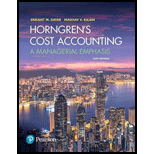
Joint-cost allocation with a byproduct. The Seattle Recycling Company (SRC) purchases old water and soda bottles and recycles them to produce plastic covers for outdoor furniture. The company processes the bottles in a special piece of equipment that first melts, then reforms the plastic into large sheets that are cut to size. The edges from the cut pieces are sold for use as package filler. The filler is considered a byproduct.
SRC can produce 25 table covers, 75 chair covers, and 5 pounds of package filler from 100 pounds of bottles.
In June, SRC had no beginning inventory. It purchased and processed 120,000 pounds of bottles at a cost of $600,000. SRC sold 25,000 table covers for $12 each, 80,000 chair covers for $8 each, and 5,000 pounds of package filler at $1 per pound.
- 1. Assume that SRC allocates the joint costs to table and chair covers using the sales value at splitoff method and accounts for the byproduct using the production method. What is the ending inventory cost for each product and gross margin for SRC?
Required
- 2. Assume that SRC allocates the joint costs to table and chair covers using the sales value at splitoff method and accounts for the byproduct using the sales method. What is the ending inventory cost for each product and gross margin for SRC?
- 3. Discuss the difference between the two methods of accounting for byproducts, focusing on what conditions are necessary to use each method.
Want to see the full answer?
Check out a sample textbook solution
Chapter 16 Solutions
Horngren's Cost Accounting: A Managerial Emphasis (16th Edition)
- need help this problemarrow_forwardWhat is the percent change in sales for year 2 compared to the base year of this financial accounting question?arrow_forwardPhoenix Industries has twelve million shares outstanding, generates free cash flows of $75 million each year, and has a cost of capital of 12%. It also has $50 million of cash on hand. Phoenix wants to decide whether to repurchase stock or invest the cash in a project that generates free cash flows of $3 million each year. Should Phoenix invest or repurchase the shares? A) Repurchase B) Invest C) Indifferent between options D) Cannot say for sure provide answerarrow_forward
 Managerial Accounting: The Cornerstone of Busines...AccountingISBN:9781337115773Author:Maryanne M. Mowen, Don R. Hansen, Dan L. HeitgerPublisher:Cengage LearningPrinciples of Accounting Volume 2AccountingISBN:9781947172609Author:OpenStaxPublisher:OpenStax College
Managerial Accounting: The Cornerstone of Busines...AccountingISBN:9781337115773Author:Maryanne M. Mowen, Don R. Hansen, Dan L. HeitgerPublisher:Cengage LearningPrinciples of Accounting Volume 2AccountingISBN:9781947172609Author:OpenStaxPublisher:OpenStax College Cornerstones of Cost Management (Cornerstones Ser...AccountingISBN:9781305970663Author:Don R. Hansen, Maryanne M. MowenPublisher:Cengage Learning
Cornerstones of Cost Management (Cornerstones Ser...AccountingISBN:9781305970663Author:Don R. Hansen, Maryanne M. MowenPublisher:Cengage Learning


